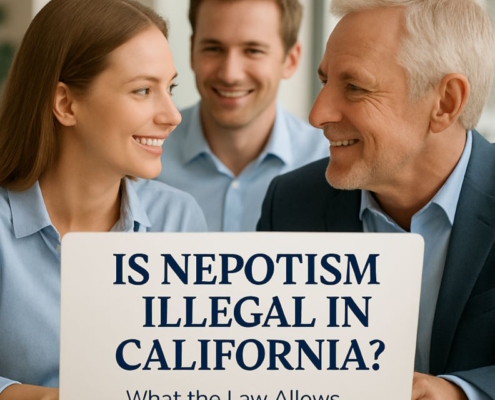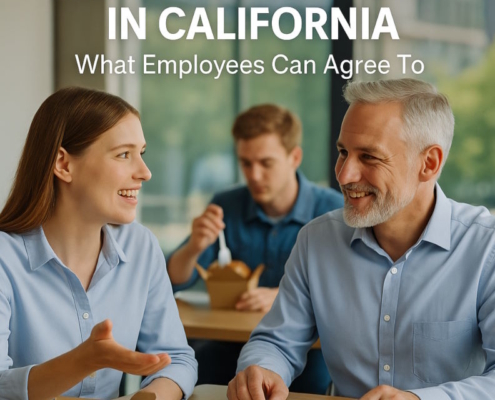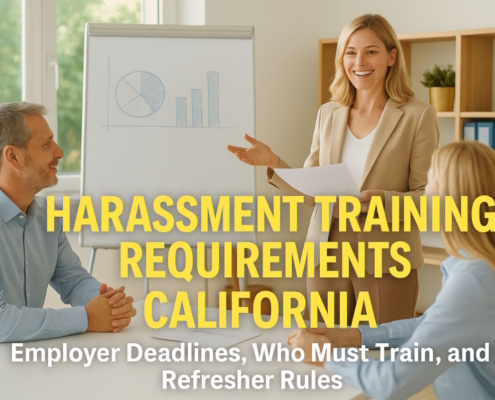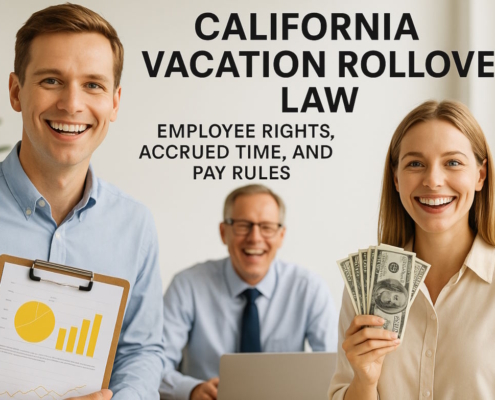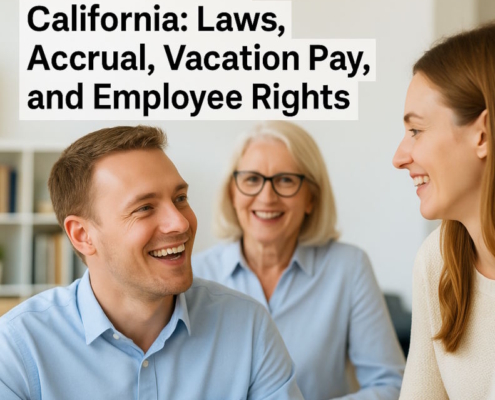Elderly Discrimination Examples
Age discrimination, also known as ageism, generally manifests as older workers being terminated, harassed, or refused promotion due to their age.
By Douglas Wade, Attorney
Email | Call (800) 484-4610
Get Smarter. Search FAQs.
What Are Examples of Age Discrimination in California?
- Unfair Disciplinary Action
Some businesses disguise their discriminatory acts by making false accusations. In these cases, employers accuse workers of bad performance, misconduct, dishonesty, or something else.
This idea is known as “pretext,” or a reason given to justify an action that is not the true reason.
Since most companies in California know that it is illegal to discriminate based on age, they use this concept of pretext to hide their unlawful practices.
For example, an older worker’s supervisor might plan to discipline them before taking an age-related action. However, let’s say that a business wants to fire an employee based on their age and not their job performance. The employee’s supervisor could complain about their job performance or accuse them of being late to work or not working well with others. These accusations could set the stage for discrimination based on age. This way, the employer can justify their actions by claiming that the firing has nothing to do with age when it does.
- Unequal Hiring of Younger Employees
Some companies base their hiring decisions on the applicants’ ages, even when this practice is illegal and discriminatory.
Prospective candidates in California should be evaluated based on their job qualifications, for example, commensurate experience, job-related talents, recommendations, and more. Vague assumptions about fitness, skills, or body types have no place in the hiring process, yet for some companies, these assumptions are commonplace.
Some employers have a history of preferring youthful workers. When this is proven to be true, the practice must be investigated because it could be evidence of a pattern of age-based discrimination.
Additionally, many employers hide this behavior. Supervisors, for example, will usually not admit that an individual is being rejected because of how old they are. Instead, the supervisor or manager will provide another reason for the rejection.
Often, the catchphrase that we hear is “overqualified.” This term is sometimes used for employers to dishonestly defend their hiring choices. This term has many synonyms; for example, some employers describe qualified employees as “not the right fit” or suggest that the job opportunity is “beneath them.” However, the employer may use these terms to describe an employee over 40 or older than 50 or 60 and then promptly hire a 25-year-old candidate with the same or less experience or expertise.
- Less Opportunity for Advancement
Sometimes, businesses hire older workers to fill a quota or to perform a single task, but the employees have little to no chance to advance in the workplace.
When employers hire older workers and then “strand them” in one place, it limits the individuals’ chances for accomplishment, building a future, learning, and advancing at the company.
Many older workers report feeling “stuck” in modern workplaces and are not encouraged to climb the ladder and continue to progress. For example, many older workers realize that no matter how well they perform or how many goals they accomplish, they will not be promoted. This lack of advancement impacts older workers mentally and psychologically.
When an employer chooses a less qualified candidate based only on their youth, this is an example of age discrimination. When an employee suspects this type of obvious age discrimination, they must immediately contact an experienced employment discrimination lawyer.
It is essential to remember that older workers can make equally valuable contributions to businesses, just like their younger counterparts. In addition, older workers have often accumulated wisdom and patience from their years in the industry. Therefore, they should never be judged based on their age, only their qualifications, and abilities.
- Workplace Harassment
Harassment at the workplace can take many different forms, from casual teasing and jokes too offensive messages and emails. All forms of harassment have no place in the workplace, and when workplace harassment creates a hostile work environment, it rises to the level of discrimination.
Older workers sometimes face harassment through jokes, teasing, and even offensive drawings. Whether older workers are teased because of their age or something else, their coworkers should never unfairly target them.
Some employers excuse harassment by describing the behavior as “just a joke” or “all in good fun,” but employers should never condone workplace harassment. When supervisors and managers do nothing about harassment or join in, they perpetuate the belief that verbal or physical harassment is acceptable.
Employers target many older workers because of their age; some are even driven to leave their jobs. When a workplace environment grows hostile, and employees feel illegally targeted, they should contact an experienced attorney to find out about their options.
- Layoffs of Older Workers
Sometimes, employers go beyond harassment and terminate their older employees based solely on their ages. Although it is illegal in California to use age to justify layoffs, many employers make up other reasons for the terminations.
All employers must lay off workers at some point, but when they target older workers, this is typically evidence of age discrimination.
Some employers terminate older workers to save money on salaries and benefits since they can hire younger workers and not pay them as much to start.
However, when it comes to being terminated for being older than 40, workers do have federal protection. Older workers also get protection under the Older Workers Benefit Protection Act (OWBPA). This federal law prevents age discrimination as a basis for business restructuring, reducing staff, or reducing benefits.
- Isolating Older Employees
All workplaces promote a certain culture, be it serious and hardworking, light and youthful, or somewhere in between.
Many older employees end up feeling isolated at work because of their age. Younger workers tend to have the same interests, and older workers sometimes struggle to relate.
Although this does not seem to be a monumental problem, this sense of isolation can make workers feel isolated and struggle with their jobs. In addition, when employees feel pushed out, they also miss out on making connections that can lead to new friendships and career advancements.
Older workers who are alone most of the day do not often get promoted or enjoy the ability to network with their peers or managers. Not only is this an emotional issue for older workers, but the issue of workplace isolation can also stagnate their careers.
When workers feel isolated, they may not have a clear claim to discrimination in the workplace. However, speaking with an employment litigation attorney can help clarify the situation, and often the conversation uncovers other damaging behavior that is ongoing.
What Are Age Discrimination Laws in California?
In the state of California, two acts protect workers:
- The Age Discrimination in Employment Act (ADEA) is a federal act.
- The California Fair Employment and Housing Act (FEHA) is a state act.
Both acts help protect workers in California from employment-related age discrimination. However, despite these important acts, age discrimination is still a complex problem in the state. Research tells us that two-thirds of employees over 45 say they have witnessed age discrimination or experienced it in the workplace.
All employers need to be familiar with how employers discriminate against workers. But unfortunately, discriminatory behavior manifests itself in many ways and is notoriously difficult to prove.
Sometimes, employees are unsure whether or not their employer is behaving in a discriminatory manner. However, whenever a worker suspects discrimination, they should be sure to document and keep records of everything that was said and everything that occurred.
In this article, we will review the ADEA and the FEHA and then briefly discuss some of California’s most common examples of elderly discrimination.
What is the Age Discrimination in Employment Act?
The Age Discrimination in Employment Act (ADEA) helps to protect prospective hires and existing employees aged 40 and older.
When employees suffer age-related discrimination, elderly or otherwise, they are often protected under the ADEA. Therefore, individuals should be familiar with the ADEA, as should their attorneys. Often, when the elderly are discriminated against, their lawyers reference the ADEA as part of their defense.
The ADEA helps to keep discrimination out of standard workplace practices, such as promotions and bonuses, hiring, terminations, salaries, and terms of employment.
Additionally, the ADEA addresses age-related discrimination, and the Equal Employment Opportunity Commission endorses the inclusion of this particular form of discrimination.
What is the Fair Employment and Housing Act?
The Fair Employment and Housing Act (FEHA) makes it unlawful for businesses to discriminate against California’s protected classes, which include:
- Age
- Sexual orientation
- Gender (including gender identity and expression)
- Disability
- Religion
- National origin
- Genetic information
- Pregnancy
- Marital status
- Race
- Medical conditions
- Pregnancy disability leave
- Request for leave for a worker’s serious health condition
- Age
- Disability
- Request for family care leave
The FEHA provides complete protection for individuals against workplace discrimination than federal law when compared to the ADEA.
Learn more about: Business | Corporate | Employment
See all articles: Business | Corporate | Employment




